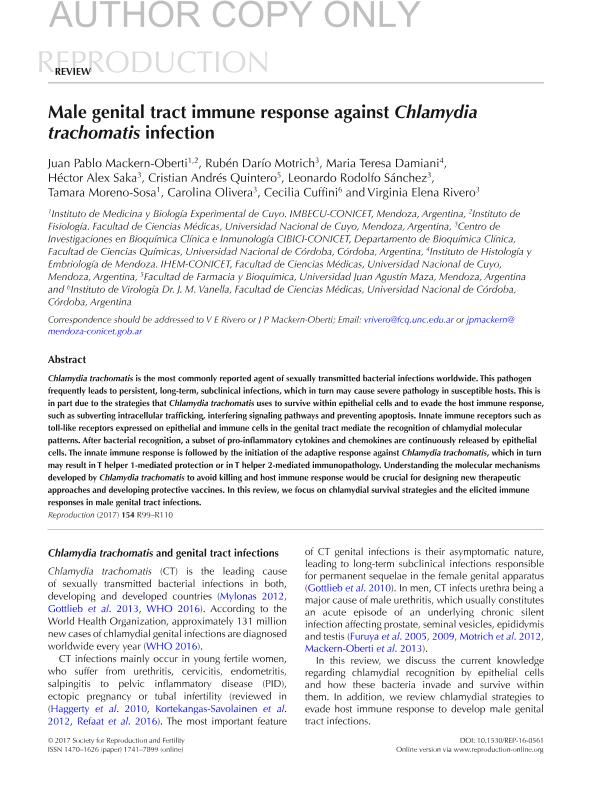Artículo
Male genital tract immune response against Chlamydia trachomatis infection
Mackern Oberti, Juan Pablo ; Motrich, Ruben Dario
; Motrich, Ruben Dario ; Damiani, María Teresa; Saka, Hector Alex
; Damiani, María Teresa; Saka, Hector Alex ; Quintero, Cristian Andre; Sanchez, Leonardo Rodolfo
; Quintero, Cristian Andre; Sanchez, Leonardo Rodolfo ; Moreno Sosa, María Tamara
; Moreno Sosa, María Tamara ; Cuffini, Cecilia Gabriela
; Cuffini, Cecilia Gabriela ; Rivero, Virginia Elena
; Rivero, Virginia Elena
 ; Motrich, Ruben Dario
; Motrich, Ruben Dario ; Damiani, María Teresa; Saka, Hector Alex
; Damiani, María Teresa; Saka, Hector Alex ; Quintero, Cristian Andre; Sanchez, Leonardo Rodolfo
; Quintero, Cristian Andre; Sanchez, Leonardo Rodolfo ; Moreno Sosa, María Tamara
; Moreno Sosa, María Tamara ; Cuffini, Cecilia Gabriela
; Cuffini, Cecilia Gabriela ; Rivero, Virginia Elena
; Rivero, Virginia Elena
Fecha de publicación:
11/07/2017
Editorial:
BioScientifica
Revista:
Reproduction
ISSN:
1470-1626
e-ISSN:
1741-7899
Idioma:
Inglés
Tipo de recurso:
Artículo publicado
Clasificación temática:
Resumen
Chlamydia trachomatis is the most commonly reported agent of sexually transmitted bacterial infections worldwide. This pathogenfrequently leads to persistent, long-term, subclinical infections, which in turn may cause severe pathology in susceptible hosts. This isin part due to the strategies that Chlamydia trachomatis uses to survive within epithelial cells and to evade the host immune response,such as subverting intracellular trafficking, interfering signaling pathways and preventing apoptosis. Innate immune receptors such astoll-like receptors expressed on epithelial and immune cells in the genital tract mediate the recognition of chlamydial molecularpatterns. After bacterial recognition, a subset of pro-inflammatory cytokines and chemokines are continuously released by epithelialcells. The innate immune response is followed by the initiation of the adaptive response against Chlamydia trachomatis, which in turnmay result in T helper 1-mediated protection or in T helper 2-mediated immunopathology. Understanding the molecular mechanismsdeveloped by Chlamydia trachomatis to avoid killing and host immune response would be crucial for designing new therapeuticapproaches and developing protective vaccines. In this review, we focus on chlamydial survival strategies and the elicited immuneresponses in male genital tract infections.
Palabras clave:
Chlamydia Trachomatis
,
Male Genital Tract
,
Fertility
Archivos asociados
Licencia
Identificadores
Colecciones
Articulos(CIBICI)
Articulos de CENTRO DE INV.EN BIOQUI.CLINICA E INMUNOLOGIA
Articulos de CENTRO DE INV.EN BIOQUI.CLINICA E INMUNOLOGIA
Citación
Mackern Oberti, Juan Pablo; Motrich, Ruben Dario; Damiani, María Teresa; Saka, Hector Alex; Quintero, Cristian Andre; et al.; Male genital tract immune response against Chlamydia trachomatis infection; BioScientifica; Reproduction; 154; 4; 11-7-2017
Compartir
Altmétricas



